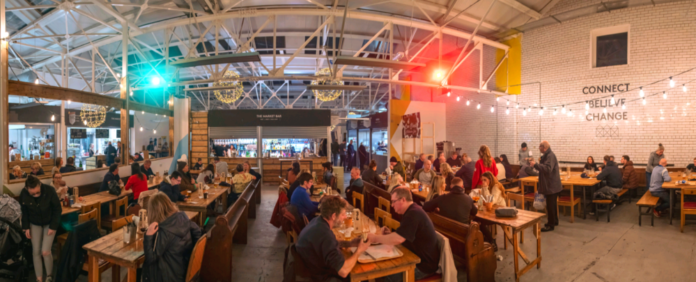Radcliffe Market has been included in a new report from international law firm Withers as a leading example of how communities can rebuild their high streets after the pandemic.
Radcliffe Market is a community-owned venue which aims to provide an inclusive environment where visitors can enjoy fresh food and access local services. The report discusses how the Covid-19 pandemic has accelerated the need for the innovative regeneration of local high streets and features Radcliffe Market as a successfu lexample of a venue that has not only put the community at the heart of its vision, but also puts local produce and environmental consideration at the forefront of its customer experience too.
It follows research by Withers into consumers’ attitudes to neighbourhood amenities and community spaces. This revealed that seven in ten (70%) think their local high street has been fundamentally changed by Covid-19 and are concerned about its future.
Nationwide, people expressed concern about the state of their high street, with many nervous about the number of empty units (69%), over half (52%) fearful that shops and restaurants they value will close in the coming year, and one in three (33%) worried that independent businesses will close, resulting in chains taking over (33%).
Despite more than three-quarters (78%) of people altering how much they used their local high street in the last 12 months, the majority (80%) of those who used nearby conveniences more said this will not continue when all Covid-19 restrictions are lifted.
Nearly half (46%) would like to see their local authority taking more proactive steps in improving their local high street, while a quarter (24%) believe it is the community that should take over the running of some or all key buildings.
Radcliffe Market, which was refurbished by the council in 2014 and then taken over by the community in 2018, is celebrated in the ‘green high street’ section of the report; thanks to its vision to connect people to fresh and local food. It also encourages all of its market traders to follow the Slow Food movement principles which preserve biodiversity, sustainability and ensure animal welfare without harming human health.
The Radcliffe Market team say that: “local food connects communities. Purchasing from local sources allows direct relationships with the producers and can create a greater sense of community and connectivity.”
The project also has local culture and collaboration at its heart and gives back to the community by donating 25% of all membership fees into helping those who need it in Radcliffe.
Jeremy Wakeham, CEO of the Withers Business Division and a commercial real estate partner added: “Without doubt the Covid-19 pandemic has worsened an already challenging situation on our high streets and accelerated the need for action. Yet there is hope and opportunity for those willing to innovate and collaborative – like the team behind Radcliffe Market. Our research has shown that people really do want their local area to succeed. Coming out of lockdown, and spending more time in their local high street, they want to have a community hub on their doorstep where they can shop, socialise, work and be entertained.
“What is also fundamentally clear is that local authorities, landlords and communities must create new partnerships and ownership models that will not only serve the varied needs of those living in the area but will also create destinations that attract both visitors and consumers. Thriving high streets of the future will not rely on retail alone but, like Radcliffe Market, will offer a carefully curated mix of services that meet the community’s demands.”
Bill Grimsey, ex retailer and contributor to the Withers report said: “The media loves this idea that the high street has to be ‘saved’, but I think you should drop the ‘save’ and replace it with ‘reinvent’. It’s all about developing social places that are fit for the 21st century.”
Claire Bailey, founder of The Retail Champion and Creator of The Future High Street Summit agreed, adding: “The high street isn’t going away, nor is it dying, but it is transforming, changing in purpose and function.
“High streets must adapt, and they can do that most effectively with proactive support from place managers (local authorities, BIDs etc), and through collaboration between all the businesses and organisations that operate within the high streets.
“High streets are there to provide local services, and it’s only by assessing the community, indeed by engaging them and discovering why they use a place, and why they don’t, can high streets evolve to meet the needs of the local community.”
The full future of the local high street report can be found at: https://reports.







